Engine Citroen DS4 2010.5 1.G Service Manual
[x] Cancel search | Manufacturer: CITROEN, Model Year: 2010.5, Model line: DS4, Model: Citroen DS4 2010.5 1.GPages: 341, PDF Size: 10.59 MB
Page 166 of 341
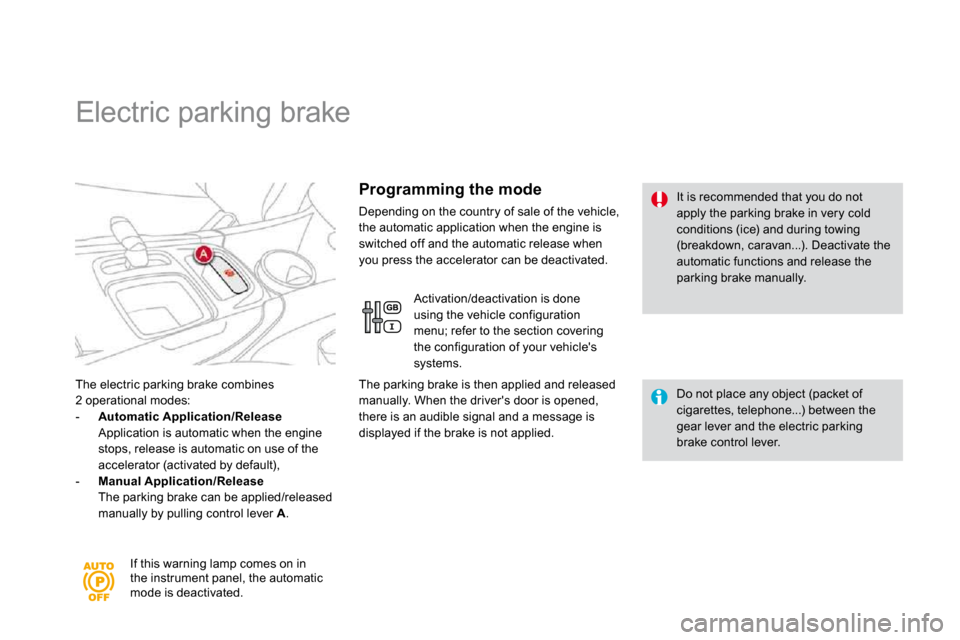
Electric parking brake
The electric parking brake combines2 operational modes: - Automatic Application/Release Application is automatic when the engine stops, release is automatic on use of the accelerator (activated by default), - Manual Application/Release The parking brake can be applied/released manually by pulling control lever A .
Do not place any object (packet of cigarettes, telephone...) between the gear lever and the electric parking brake control lever.
It is recommended that you do not apply the parking brake in very cold conditions (ice) and during towing (breakdown, caravan...). Deactivate the automatic functions and release the parking brake manually.
If this warning lamp comes on in the instrument panel, the automatic mode is deactivated.
Programming the mode
Depending on the country of sale of the vehicle,
the automatic application when the engine is switched off and the automatic release when you press the accelerator can be deactivated.
Activation/deactivation is done using the vehicle configuration menu; refer to the section covering the configuration of your vehicle's systems.
The parking brake is then applied and released manually. When the driver's door is opened, there is an audible signal and a message is displayed if the brake is not applied.
Page 167 of 341
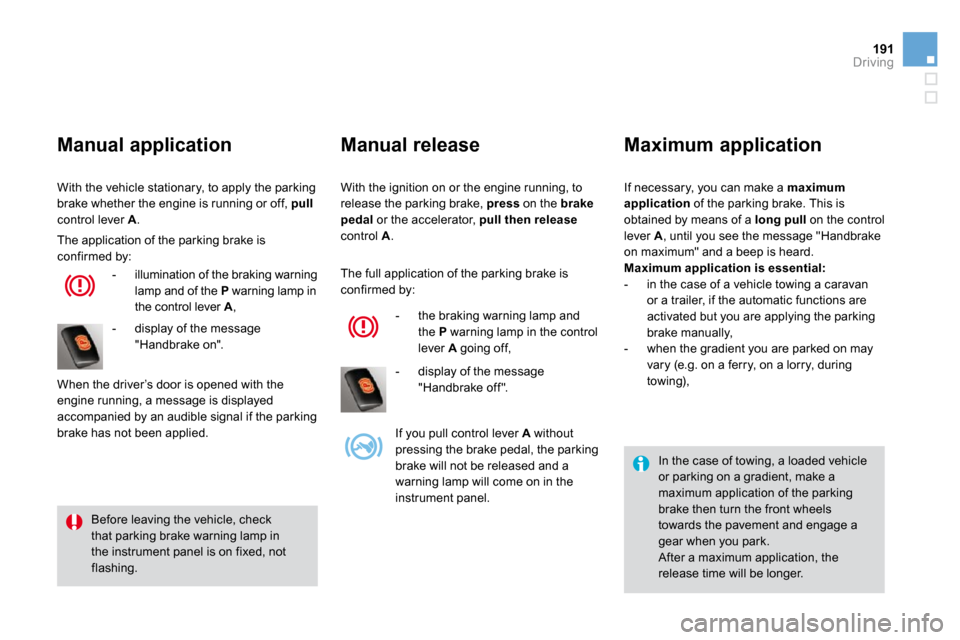
191Driving
With the ignition on or the engine running, to release the parking brake, press on the brake pedal or the accelerator, pull then release control A .
Manual release
Before leaving the vehicle, check that parking brake warning lamp in the instrument panel is on fixed, not flashing.
Manual application
With the vehicle stationary, to apply the parking brake whether the engine is running or off, pullcontrol lever A .
The application of the parking brake is confirmed by:
- illumination of the braking warning lamp and of the P warning lamp in the control lever A ,
- display of the message "Handbrake on".
When the driver’s door is opened with the engine running, a message is displayed accompanied by an audible signal if the parking brake has not been applied.
The full application of the parking brake is confirmed by:
- the braking warning lamp and the P warning lamp in the control lever A going off,
- display of the message "Handbrake off ".
If you pull control lever A without pressing the brake pedal, the parking brake will not be released and a warning lamp will come on in the instrument panel.
Maximum application
If necessary, you can make a maximum application of the parking brake. This is obtained by means of a long pull on the control lever A , until you see the message "Handbrake on maximum" and a beep is heard. Maximum application is essential: - in the case of a vehicle towing a caravan or a trailer, if the automatic functions are activated but you are applying the parking brake manually, - when the gradient you are parked on may vary (e.g. on a ferry, on a lorry, during towing),
In the case of towing, a loaded vehicle or parking on a gradient, make a maximum application of the parking brake then turn the front wheels towards the pavement and engage a gear when you park. After a maximum application, the release time will be longer.
Page 168 of 341
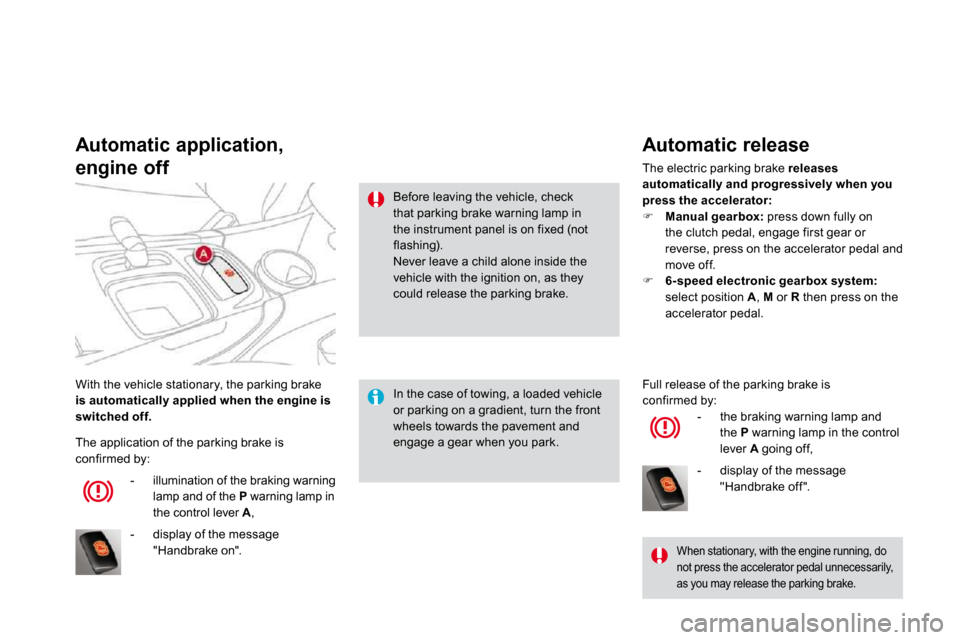
With the vehicle stationary, the parking brake is automatically applied when the engine is switched off.
Automatic application,
engine off
In the case of towing, a loaded vehicle or parking on a gradient, turn the front wheels towards the pavement and engage a gear when you park.
Before leaving the vehicle, check that parking brake warning lamp in the instrument panel is on fixed (not flashing). Never leave a child alone inside the vehicle with the ignition on, as they could release the parking brake.
- illumination of the braking warning lamp and of the P warning lamp in the control lever A ,
- display of the message "Handbrake on".
The application of the parking brake is confirmed by:
Automatic release
The electric parking brake releases automatically and progressively when you press the accelerator: � Manual gearbox: press down fully on the clutch pedal, engage first gear or reverse, press on the accelerator pedal and move off. � 6-speed electronic gearbox system:select position A , M or R then press on the accelerator pedal.
When stationary, with the engine running, do not press the accelerator pedal unnecessarily, as you may release the parking brake.
Full release of the parking brake is confirmed by: - the braking warning lamp and the P warning lamp in the control lever A going off,
- display of the message "Handbrake off ".
Page 169 of 341
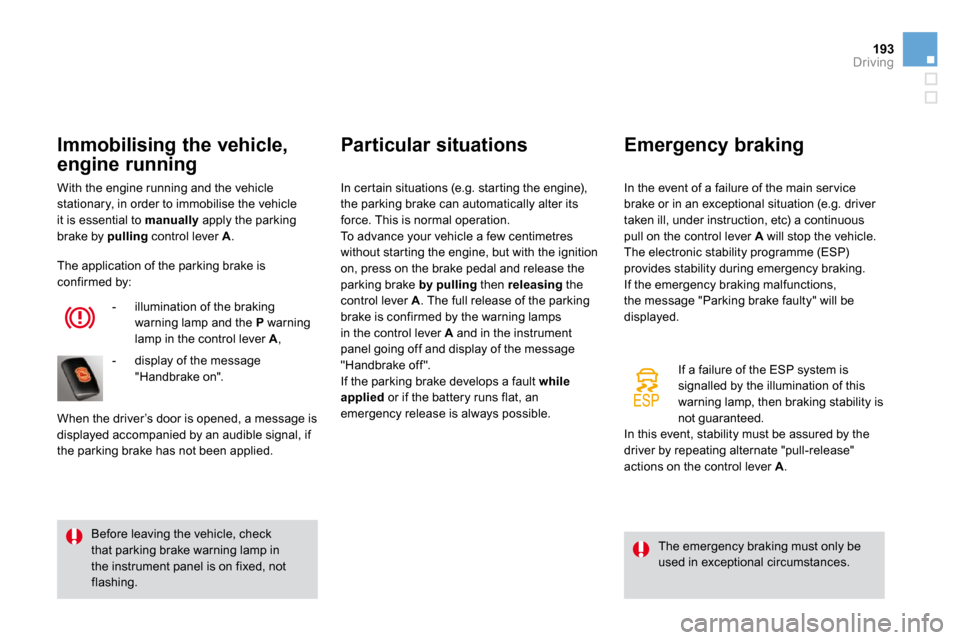
193Driving
With the engine running and the vehicle stationary, in order to immobilise the vehicle it is essential to manually apply the parking
brake by pulling control lever A .
Immobilising the vehicle,
engine running
The emergency braking must only be used in exceptional circumstances.
Before leaving the vehicle, check that parking brake warning lamp in the instrument panel is on fixed, not flashing.
The application of the parking brake is confirmed by:
- illumination of the braking warning lamp and the P warning lamp in the control lever A ,
- display of the message "Handbrake on".
When the driver’s door is opened, a message is displayed accompanied by an audible signal, if the parking brake has not been applied.
Particular situations
In cer tain situations (e.g. star ting the engine), the parking brake can automatically alter its force. This is normal operation.
To advance your vehicle a few centimetres without star ting the engine, but with the ignition on, press on the brake pedal and release the parking brake by pulling then releasing the control lever A . The full release of the parking brake is confirmed by the warning lamps in the control lever A and in the instrument panel going off and display of the message "Handbrake off ". If the parking brake develops a fault while applied or if the battery runs flat, an emergency release is always possible.
Emergency braking
If a failure of the ESP system is signalled by the illumination of this warning lamp, then braking stability is not guaranteed. In this event, stability must be assured by the driver by repeating alternate "pull-release" actions on the control lever A .
In the event of a failure of the main ser vice brake or in an exceptional situation (e.g. driver taken ill, under instruction, etc) a continuous
pull on the control lever A will stop the vehicle. The electronic stability programme (ESP) provides stability during emergency braking. If the emergency braking malfunctions, the message "Parking brake faulty" will be displayed.
Page 170 of 341
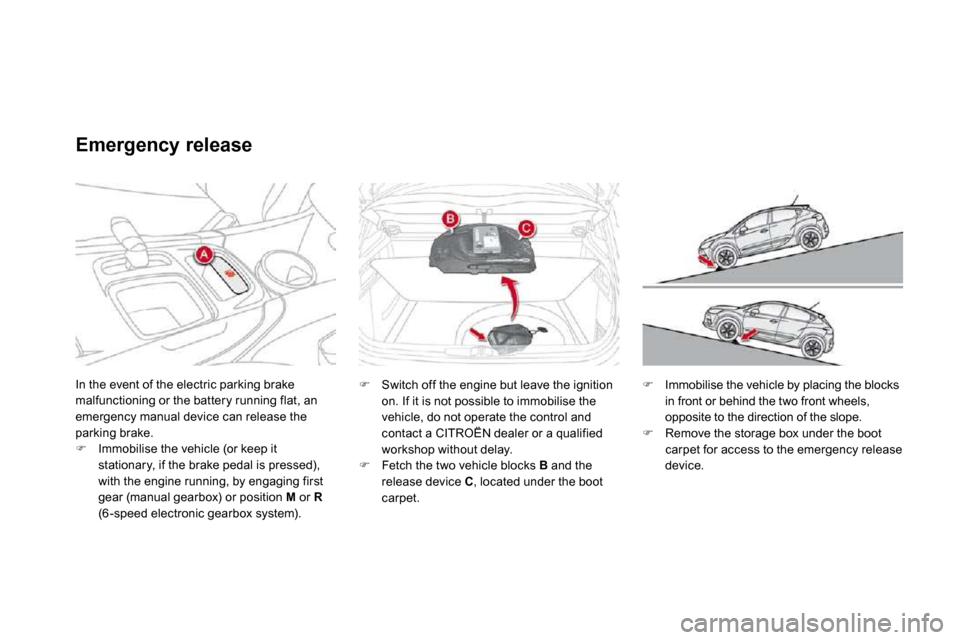
In the event of the electric parking brake malfunctioning or the battery running flat, an emergency manual device can release the parking brake. � Immobilise the vehicle (or keep it stationary, if the brake pedal is pressed), with the engine running, by engaging first gear (manual gearbox) or position M or R(6 -speed electronic gearbox system).
Emergency release
� Switch off the engine but leave the ignition on. If it is not possible to immobilise the vehicle, do not operate the control and contact a CITROËN dealer or a qualified workshop without delay. � Fetch the two vehicle blocks B and the release device C , located under the boot carpet.
� Immobilise the vehicle by placing the blocks in front or behind the two front wheels, opposite to the direction of the slope. � Remove the storage box under the boot carpet for access to the emergency release device.
Page 171 of 341
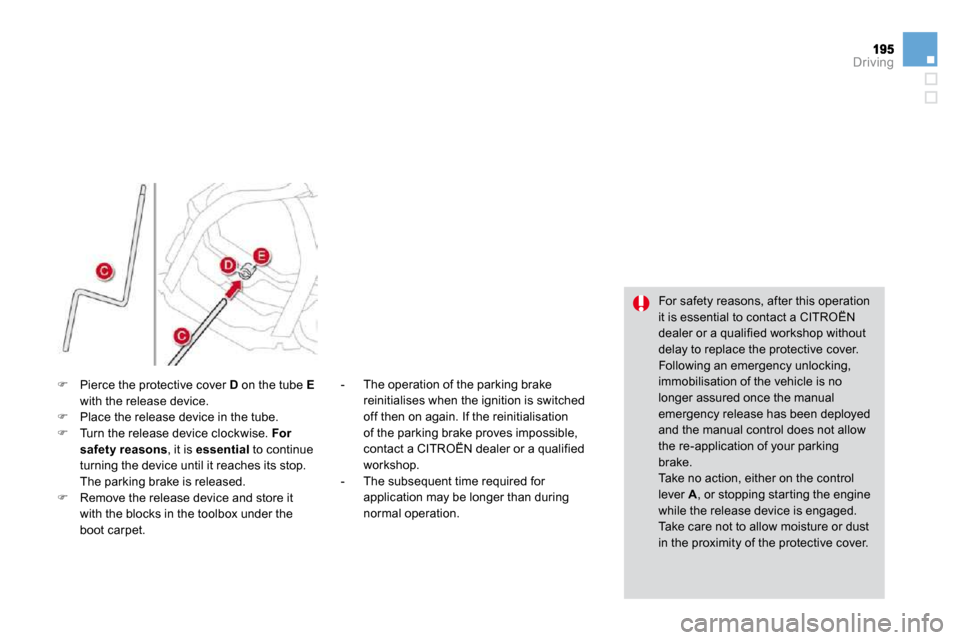
Driving
� Pierce the protective cover D on the tube Ewith the release device. � Place the release device in the tube. � Turn the release device clockwise . For safety reasons , it is essential to continue turning the device until it reaches its stop. The parking brake is released. � Remove the release device and store it with the blocks in the toolbox under the boot carpet.
For safety reasons, after this operation it is essential to contact a CITROËN dealer or a qualified workshop without delay to replace the protective cover. Following an emergency unlocking, immobilisation of the vehicle is no longer assured once the manual emergency release has been deployed
and the manual control does not allow the re-application of your parking brake.
Take no action, either on the control lever A , or stopping star ting the engine while the release device is engaged. Take care not to allow moisture or dust
in the proximity of the protective cover.
- The operation of the parking brake reinitialises when the ignition is switched off then on again. If the reinitialisation of the parking brake proves impossible, contact a CITROËN dealer or a qualified workshop. - The subsequent time required for application may be longer than during normal operation.
Page 173 of 341

197Driving
SituationsConsequences
To apply the electric parking brake: � immobilise the vehicle and switch off the ignition. � pull the control for at least 5 seconds or until app lication is complete. � switch on the ignition and check the switching on of the electric parking brake warning lamps. The application is slower than during normal operati on. To release the electric parking brake: � switch on the ignition. � pull the control and hold it for approximately 3 seconds then release it. If the braking warning lamp is flashing or if the warning lamps do not come on with the ignition on, these procedures will not work. Pla ce the vehicle on level ground and have it checked by a CITROËN dealer or a qualified workshop.
and possibly
flashing
Display of the message " Parking brake fault " and of the following warning lamps: - Only the automatic application on switching off the engine and automatic release on acceleration functions are available. - The manual application/release of the electric p arking brake and the emergency braking are not available.
and possibly
flashing
Battery fault - If the battery warning lamp comes on you must st op immediately as soon as the traffic allows. Stop and immobilise your vehicle (if necessary, place the two chocks under the wheels). - Apply the electric parking brake before switching off the engine.
Page 175 of 341

199Driving
6-speed manual gearbox
� Raise the ring under the knob and push the gear lever to the left then for wards.
Engaging reverse gear
As a safety precaution and to facilitate star ting of the engine: - always select neutral, - press the clutch pedal.
Only engage reverse gear when the vehicle is stationary with the engine at idle.
Page 176 of 341

Gear shift indicator *
Operation
The system inter venes only when driving economically.
Depending on the driving situation and your vehicle's equipment, the system may advise you to skip one or more gears. You can follow this instruction without engaging the intermediate gears. The gear engagement recommendations must not be considered compulsory. In fact, the configuration of the road, the amount of traffic and safety remain determining factors when choosing the best gear. Therefore, the driver remains responsible for deciding whether or not to follow the advice given by the system. This function cannot be deactivated.
- The system may suggest that you engage a higher gear, if appropriate.
The information appears in the instrument panel screen in the form of an arrow accompanied by the suggested gear.
In the case of driving which makes par ticular demands on the per formance of the engine (firm pressure on the accelerator pedal, for example, when over taking...), the system will not recommend a gear change. The system never suggests: - engaging first gear, - engaging reverse gear, - engaging a lower gear.
* According to engine.
Example:
- You are in third gear.
- You press the accelerator pedal moderately.
Page 178 of 341

Gear lever positions
N. Neutral R. Reverse 1, 2, 3, 4, 5, 6. Gears in manual mode. AUTO. This comes on when the automatic mode is selected. It switches off on changing to manual mode.
Displays in the instrument panel
� Place your foot on the brakewhen this warning lamp flashes (e.g.: when star ting the engine).
Moving off
N flashes in the instrument panel, accompanied by an audible signal and a message in the multifunction screen, if the gear lever is not in position N on star ting. Foot on brake flashes on the instrument panel, accompanied by an audible signal and a message in the multifunction screen, if the brake pedal is not pressed on star ting.
� Select position N . � Press the brake pedal down fully. � Star t the engine.
Engagement of reverse gear is accompanied by an audible signal.
N appears in the instrument panel screen.
� Select first gear (position M or A ) or Areverse (position R ). R� Release the parking brake unless it is programmed to automatic mode. � Take your foot off the brake pedal, then accelerate.
AUTO and 1 or R appear in the instrument panel screen.